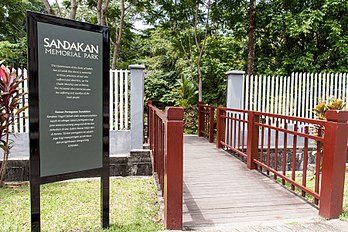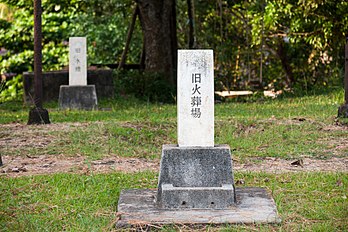Japanese occupation of British Borneo
Japanese-occupied British Borneo (British North Borneo, Brunei, Labuan and Sarawak) North Borneo (北ボルネオ, Kita Boruneo) | |||||||||||||||
|---|---|---|---|---|---|---|---|---|---|---|---|---|---|---|---|
| 1941–1945 | |||||||||||||||
| Motto: Eight Crown Cords, One Roof (八紘一宇, Hakkō Ichiu) | |||||||||||||||
| Anthem: "Kimigayo"
| |||||||||||||||
Emperor | | ||||||||||||||
• 1941–1945 | Shōwa (Hirohito) | ||||||||||||||
| Governor-General | |||||||||||||||
• 1941–1942 | Kiyotake Kawaguchi | ||||||||||||||
• 1942 | Toshinari Maeda | ||||||||||||||
• 1942–1944 | Masataka Yamawaki | ||||||||||||||
• 1944–1945 | Masao Baba | ||||||||||||||
| Historical era | Allied liberation of northern Borneo | 10 June 1945 | |||||||||||||
| 15 August 1945 | |||||||||||||||
| set up | 12 September 1945 | ||||||||||||||
• Return to pre-war administrative position | 1 April 1946 | ||||||||||||||
| Population | |||||||||||||||
• 1945 | 950,000[note 1][3] | ||||||||||||||
| Currency | Japanese-issued dollar ("Banana money") | ||||||||||||||
| |||||||||||||||
| Today part of | Brunei Malaysia | ||||||||||||||
Before the outbreak of
On 16 December 1941, Japanese forces landed at
British Borneo was occupied by the Japanese for over three years. They actively promoted the
Towards the end of 1945,
Background

The Japanese intention to gain control of Borneo was associated with the concept of a unified Greater East Asia. This was developed by General Hachirō Arita, an army ideologist who served as Minister for Foreign Affairs from 1936 to 1940.[9] Japanese leaders envisioned an Asia guided by Tokyo with no western interference and likened the Japanese Empire to an Asian equivalent of the Monroe Doctrine.[10] The island was seen by Japan as strategically important, being located on the main sea routes between Java, Sumatra, Malaya and the Celebes. Control of these routes was vital to securing the territory.[11][12]

With the
Invasion
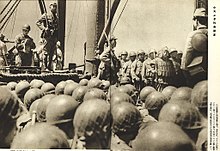
The Japanese invasion plan called for the British territories to be taken and held by the

Kuala Belait and Lutong were captured on the same day with around 10,000 Japanese soldiers ashore.[25][28] On 22 December, Brunei Town was captured and the main Japanese force moved westwards towards Kuching after securing the oilfields in northern Sarawak. The Japanese air force bombed Singkawang airfield to deter any Dutch attack. After escorts drove off a lone Dutch submarine, the Japanese task force entered the mouth of the Santubong River on 23 December.[28] The convoy, including twenty transports carrying Japanese troops commanded by Colonel Akinosuke Oka, arrived off Cape Sipang and had completed disembarkation by the next morning. The 2nd Battalion of the 15th Punjab Regiment, which was stationed in Kuching, was the sole Allied infantry unit on the island. Although they resisted the Japanese attack on the airfield, they were soon outnumbered and retreated up the Santubong River. On 25 December, Japanese troops successfully captured Kuching airfield. The Punjab Regiment retreated through the jungle to the Singkawang area.[28]
After the Japanese secured Singkawang on 29 December, the rest of the British and Dutch troops retreated further into the jungle, moving south to
Propaganda and assimilation
The Tokyo-based
As part of the process of
Local customs, practices and religions shall not be interfered with for the time being. The impact of the war on native livelihood should be alleviated where possible and within the limits set by the need for rendering occupational forces self-sufficient and securing resources vital to national defence. However, no measures shall be taken for the sole purpose of placating the natives. [Emphasis added.][33]
A different principle applied to the local Chinese as they were considered to be the only community which could offer a serious challenge to Japanese authority:
The main objective, where the local Chinese are concerned, shall be to utilise their existing commercial organisations and practices to the advantage of our policies ... and measures shall be taken to sever political ties among the Chinese residents of the various areas as well as between them and mainland China.[33]
Attempts were also made to inculcate anti-Western feeling with local government officers required to attend Japanese night classes. Unlike his counterparts in North Borneo and Sarawak which were previously ruled by European officials, the Brunei Sultan, Ahmad Tajuddin, was retained by the Japanese with no reduction in salary. Malay government officials were usually retained in their posts.[34]
Administration
Administrative areas
Under the Japanese occupation British Borneo were divided into five provinces (shūs):[6][35][36]
- Kyūchin-shū (久鎮州): Sarawak First and Second Divisions, Natuna Islands.[note 2]
- Shibu-shū (志布州): Sarawak Third Division
- Miri-shū (美里州): Sarawak Fourth and Fifth Divisions, Brunei Town.
- Seigan-shū (西岸州): Western North Borneo of and Labuan.
- Tōgan-shū (東岸州): Eastern North Borneo of Elopura, Beluran, Lahad Datu and Tawau.
Each of the five shūs had a Japanese provincial governor, or the administration remained in the hands of the local people with Japanese surveillance.[37] Each of the provinces constituted prefectures or ken (県).[35] Jesselton and Sandakan were renamed Api and Elopura respectively.[38]
Occupation forces
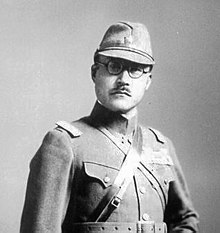
Once Sarawak was secured, control of the rest of British Borneo fell to the Kawaguchi Detachment, while neighbouring Dutch Borneo was administered by the IJN.[5] In mid-March 1942, the navy detachment was redeployed to Cebu. The 4th Independent Mixed Regiment, also known as the Nakahata Unit, under Colonel Nakahata Joichi took over the tasks of mopping up operations, maintaining law and order, and establishing a military government. On 6 April 1942, the unit came under Lieutenant General Marquess Toshinari Maeda's Borneo Defence Army who became responsible for the area. His headquarters was initially at Miri, but Maeda considered it unsuitable and moved to Kuching.[39] In July the Nakahata Regiment was reorganised into two 500-man battalions, the 40th and 41st Independent Garrison Infantry Battalions. Maeda was killed along with Major Hataichi Usui and Pilot-Captain Katsutaro Ano in an air crash while flying to Labuan Island on 5 September 1942.[12] The Japanese then renamed the island Maeda Island (前田島, Maeda-shima) in remembrance to him.[35] Maeda was replaced by Lieutenant General Masataka Yamawaki from 5 September 1942 to 22 September 1944.[12]
By 1943 the battalions combined strength had reduced to 500 men. The military government moved its headquarters again in April 1944 to Jesselton. Yamawaki was formerly Director of the Resources Mobilisation Bureau; his appointment in 1942 was interpreted by the Allies as part of a drive to establish Borneo as a significant location for storage of supplies and the development of supporting industry.
Military infrastructure and bases

Airfields were constructed by prisoners of war and conscripted labour from various locations, including from Brunei, Labuan, Ranau and Elopura.[44][45] Before the Japanese occupation, there were only three airfields: in Kuching; Miri; and Bintulu in Sarawak, while in North Borneo there were none.[46] Due to this, the Japanese planned to construct a total of twelve airfields in different parts of northern Borneo to strengthen its defence, of which seven were to be located in Api, Elopura, Keningau, Kudat, Tawau, Labuan and Lahad Datu.[46] The Japanese also launched a series of road projects in North Borneo, with the roads linking Ranau with Keningau and Kota Belud with Tenghilan to be improved as well a new road linking Kudat and Kota Belud to be constructed. As these roads passed through mountainous areas, a large number of forced labourers were needed to realise the projects.[46] In preparing for Allied retaliation Lieutenant general Masataka Yamawaki created an indigenous force consisting of around 1,300 men in 1944. Most of them were stationed in Kuching, with others in Miri, Api and Elopura; all were tasked to maintain peace and order, gather intelligence and to recruit.[47] Brunei harbour was also used by the IJN as a refuelling depot and as a staging post for the Battle of Leyte Gulf.[48]
Prisoner of war camps

The Japanese had major
Effects of occupation
Economy
Following the occupation government offices re-opened on 26 December 1941.
All motor vehicles were confiscated by Japan Transport Co. for limited compensation. The Japanese recruited labours to construct airfields for extra food and payment, while detainees were forced to work.
The Japanese particularly exploited the Chinese community, mainly due to their support for the Kuomintang and contributions to the China Relief Fund and British war efforts. The elites in major towns bore the heaviest burden and those with lesser resources went bankrupt.[56] The military government strictly controlled Chinese businesses, those who were unwilling were forcibly encouraged.[55] Japanese policy in this area was summarised in Principles Governing the Implementation of Measures Relative to the Chinese [Kakyō Kōsaku Jisshi Yōryō] issued by the Japanese headquarters in Singapore in April 1942.[56]
Before the invasion, the Japanese government had printed unnumbered military yen notes for use in all occupied territories in Southeast Asia.[57][58] Increasing inflation coupled with Allied disruption of Japan's economy forced the Japanese administration to issue banknotes of larger denominations and increase the amount of money in circulation. From January 1942 the Japanese set the military notes at par with the national yen.[59]
Residents
Effects of the occupation among the local population varied widely. The Japanese allowed
With the sparse and widely dispersed local population in northern Borneo, the Japanese military administration had little choice but to rely on forced labour from abroad, mainly from elsewhere in the Dutch East Indies and occupied China, under the management of the North Borneo Labour Business Society (Kita Boruneo Romukyokai).[60] Chinese skilled workers were brought from Shanghai, Guangzhou and Shantou, and Indonesians from Java. Although all workers were provided with board and lodging, the Chinese received better treatment as they were considered to be the more skilled workers.[60] Most of the Javanese workers were sent to Brunei,[61] while the more skilled Chinese workers were employed in boat-building in Kuching and Elopura.[60] Young Chinese males attempted to avoid being captured for forced labour, while young Chinese females were terrified of being taken as comfort women.[62] Many coastal inhabitants fled to avoid these threats. A search for Chinese agitators on the Mantanani Islands in February 1944 led to the mass killing of 60 Suluk and several Chinese civilians.[63]

As both
Resistance
Albert Kwok
, leader of a resistance movement in North BorneoOn the west coast of North Borneo, a resistance movement developed led by Albert Kwok, a Chinese from Kuching, who after working with the China Red Cross moved to Jesselton in 1940.[65] He collaborated with local indigenous groups in North Borneo.[66] After establishing contact with American forces in the Philippines Kwok travelled to Tawi-Tawi for training. He returned with three pistols, a box of hand grenades and a promise of further weapons.[67] However, the promised weapons were not delivered and Kwok had to launch a revolt with his locals armed with only knives and spears.[68]
Though they were poorly equipped, the attack still managed to kill at least 50 Japanese soldiers and temporarily capture Api, Tuaran and Kota Belud in early November.[2][69][70] As the Japanese began to retaliate, Kwok's force retreated to their hide-out.[71] The Japanese launched ruthless counter-measures, bombing coastal settlements and machine-gunning local people.[70][72] Almost all villages in the area were burnt down and 2,000–4,000 civilians were executed.[73][74] The Japanese threatened further mass civilian killings and so Kwok surrendered with several of his senior aides. They were executed on 21 January 1944 in Petagas, Putatan. After the failed uprising the Japanese conducted regular reprisals. The inhabitants of North Borneo were unable to organise a further uprising due to the level of Japanese surveillance.[75][76]
Force Z
As part of the Borneo Campaign Australian commandos were landed using US submarines.[77] The Allied Z Special Unit began to train Dayak people from the Kapit Division in guerrilla warfare. This army of tribesmen killed or captured some 1,500 Japanese soldiers. They also provided intelligence vital to securing Japanese-held oil fields and to facilitating the landings of Australian forces in June 1945. Most of the Allied activities were conducted under two intelligence and guerrilla warfare operations: Operation Agas in North Borneo; and Operation Semut in Sarawak.[78] Tom Harrisson, a British anthropologist, journalist and co-founder of Mass-Observation was among those parachuted in to work with the resistance.[79]
Liberation
The Allies organised a liberation mission known as the Operation Oboe Six to reconquer the northern part of Borneo. This followed their success with Operations Oboe One and Oboe Two.[80][81] Under the cover of a naval and aerial bombardment, the 9th Australian Division landed on Borneo and Labuan on 10 June with a force of around 14,000 personnel.[81] With narrow roads and swampy conditions near the island beaches, the unloading operations by Royal Australian Engineers were hampered. Landings in the Brunei Bay area went more easily. The prediction of strong Japanese resistance proved inaccurate, with only few air raids against the Allied forces.[82]
The
After securing Labuan, the 24th Infantry Brigade was landed on the northern shore of Brunei Bay on 16 June, while the 20th Infantry Brigade continued to consolidate the southern lodgement by advancing south-west along the coast towards Kuching.[84] The 2/32nd Battalion landed at Padas Bay and seized the town of Weston before sending out patrols towards Beaufort, 23 kilometres (14 mi) inland. The town was held by around 800–1,000 Japanese soldiers and on 27 June an attack was carried out by the 2/43rd Battalion.[84] Amid a torrential downpour and in difficult terrain, the 2/32nd Battalion secured the south bank of the Padas River. Meanwhile, one company from the 2/43rd was sent to take the town and another marched to the flanks, to take up ambush positions along the route that the Japanese were expected to withdraw along. The 2/28th Battalion secured the lines of communication north of the river.[85]
On the night of 27/28 June, the Japanese launched six counter-attacks. Amid appalling conditions, one Australian company became isolated and the next morning another was sent to attack the Japanese from the rear.[86] Fighting its way through numerous Japanese positions, the company killed at least 100 Japanese soldiers and one of its members, Private Tom Starcevich was later awarded the Victoria Cross for his efforts.[86] Following this, the Japanese withdrew from Beaufort and the Australians began a slow, cautious advance, using indirect fire to limit casualties. By 12 July they occupied Papar,[87] and from there sent out patrols to the north and along the river until the cessation of hostilities.[88] In August the fighting came to an end. The division's total casualties in the operation were 114 killed and 221 wounded, while the Japanese losses were at least 1,234.[84][89]
-
Australian troops from the 2/43rd Battalion advance with a Matilda tank on Maeda-shima in a sweep mission to clear the area of Japanese troops, 12 June 1945
-
Members of the Australian 2/17th Battalion inspecting the bodies of dead Japanese soldiers in Brunei during an operation on 13 June 1945
-
Indigenous peoples carrying Japanese rifles walking along a street in Brunei on their return to their villages on 17 June 1945
Aftermath
Japanese surrender
After the surrender of Japan on 15 August 1945 Lieutenant General Masao Baba, commander of Japanese forces in northern Borneo, surrendered at Layang-layang beach of Labuan on 9 September. He was then brought to the headquarters of Australian 9th Division, where at the official surrender ceremony on 10 September he signed the surrender document and handed over his sword to the divisional commander, Major General George Wootten.[90][91] The location became known as Surrender Point.[92]
It was estimated that around 29,500 Japanese remained on the island. 18,600 belonged to the IJA, 10,900 to the IJN.[93] The greatest concentrations of Japanese troops were in the interior.[94] There were some Japanese who refused to surrender and moved further inland. After calls from Lieutenant general Baba they also surrendered.[95] The Japanese repatriation following the surrender took several months, delayed due to lack of shipping. It was supervised by the Australians as Borneo along with New Guinea, Papua and the Solomon Islands were under their authority.[96] Australian forces also supervised the destruction of Japanese weapons and ammunition and the evacuation of internees and Allied POWs from Japanese camps.[97]
The British Military Administration (BMA) took over the task of management from the Australians on 12 September 1945 and summarised the situation towards the end of October:
In
The observation revealed that despite the destruction caused by the Allied bombardments, there were few Japanese casualties.[98] Widespread malnutrition and disease amongst the population was caused by acute food shortages.[99] In response the BMA provided food and medical supplies and reconstructed the public infrastructure, including roads, bridges, the rail network, sewerage and water supplies.[98]
-
Baba signs the surrender document in Labuan, British Borneo, being watched by Australian Major General George Wootten and other Australian units on 10 September 1945
-
Disarmed Japanese troops marching towards a prisoner of war compound in Api after surrendering to the Australians on 8 October 1945
-
Japanese civilians and soldiers leaving North Borneo after the surrender of Japan
War crimes trials
The Australians held
Many
-
Presiding members of thewar crimes trials in Labuanon 20 December 1945
-
Captain Susumi Hoshijima (centre) during the war crimes trial in Labuan, January 1946. He was found guilty of causing the deaths of POWs at Sandakan camp and subsequently hanged in 1946.[101]
Honours and legacy
War memorials

To honour the sacrifices of fallen liberators during operations for the recovery of Borneo, a cemetery named the
The Petagas War Memorial garden is built on the site where hundreds of people, including women and children, were massacred by the Japanese.[110][111] The memorial lists 324 members of Kinabalu guerrillas of various races and ethnic groups. Other memorials such as the Kundasang War Memorial, the Last POW Camp Memorial and Quailey's Hill Memorial are dedicated to Australian and British soldiers who died in the death marches as well to honouring the sacrifices of the native population. Sandakan Memorial Park is built on the site of Sandakan Camp to honour POWs and internees. The Cho Huan Lai Memorial is dedicated to the Chinese Consulate General and several colleagues who were executed by the Japanese. The Sandakan Massacre Memorial is dedicated to 30 Chinese who were executed by the Japanese for being members of underground movements. The Sandakan War Monument is dedicated to the citizens of the town who died in the war. For bravery in fighting the Japanese in close combat Tom Starcevich was honoured with the Starcevich Monument. The Japanese also remembered, through the Jesselton Japanese Cemetery, Sandakan Japanese Cemetery and Tawau Japanese War Memorial.[112]
-
Australian troops inspecting the Labuan War Cemetery after its opening ceremony on 10 September 1945
-
Batu Lintang Memorial
See also
Notes
- ^ The population was made up of:
Sarawak: 580,000;
Brunei: 39,000;
North Borneo: 331,000 - Pontianakand its adjacent islands
Footnotes
- ^ 日本サラワク協会 1998.
- ^ a b c Kratoska 2013, p. 111.
- ^ Vinogradov 1980, p. 73.
- ^ Tregonning 1965, p. 216.
- ^ a b Ooi 2010, p. 133.
- ^ a b Braithwaite 2016, p. 253.
- ^ a b Jude 2016.
- ^ Baldacchino 2013, p. 74.
- ^ Iriye 2014, p. 76.
- ^ Kawamura 2000, p. 134.
- ^ a b c Jackson 2006, p. 438.
- ^ a b c d e Broch 1943.
- ^ Akashi & Yoshimura 2008, p. 23.
- ^ a b c Ringgit 2015.
- ^ 文原堂 1930.
- ^ Saya & Takashi 1993, p. 54.
- ^ Kennedy 1969, p. 344.
- ^ Rogers 1995, p. 157.
- ^ D. Rhodes 2001, p. 201.
- ^ Schmidt 2005, p. 140.
- ^ Black 2014, p. 150.
- ^ Mendl 2001, p. 190.
- ^ Lightner 2001, p. 30.
- ^ Steiner 2011, p. 483.
- ^ a b Dhont, Marles & Jukim 2016, p. 7.
- ^ Ooi 2013, p. 15.
- ^ Rottman 2013, p. 17.
- ^ a b c d e f g Klemen 2000.
- ^ Chay 1988, p. 13.
- ^ a b Ooi 2013, p. 1822.
- ^ a b de Matos & Caprio 2015, p. 43.
- ^ a b Tan 2011.
- ^ a b c d de Matos & Caprio 2015, p. 44.
- ^ a b Saunders 2013, p. 122.
- ^ a b c Tarling 2001, p. 193.
- ^ "The Japanese Occupation of Borneo" (PDF). Archived from the original (PDF) on 15 April 2021. Retrieved 25 January 2021.
- ^ Ooi 2013, p. 1823.
- ^ Ham 2013, p. 51.
- ^ Ooi 2010, p. 92.
- ^ Reece 1993, p. 74.
- ^ Felton 2009, p. 169.
- ^ Ooi 2010, p. 101.
- ^ Ooi 1999, p. 90.
- ^ FitzGerald 1980, p. 88.
- ^ Chandran 2017.
- ^ a b c Kratoska 2013, p. 117.
- ^ Lebra 2010, p. 133.
- ^ Woodward 2017, p. 38.
- ^ Ooi 2010, p. 69.
- ^ Fuller 1999.
- ^ Muraoka 2016, p. 107.
- ^ a b c Ooi 1999, p. 125.
- ^ Braithwaite 1989, p. 157.
- ^ Hong 2011, p. 232.
- ^ a b Ooi 2010, p. 112.
- ^ a b de Matos & Caprio 2015, p. 47.
- ^ Lee 1990, p. 17.
- ^ Ooi 2013, p. 1782.
- ^ Hirakawa & Shimizu 2002, p. 133.
- ^ a b c Ooi 2010, p. 110.
- ^ Ooi 2013, p. 56.
- ^ Ooi 2013, p. 29.
- ^ Tay 2016.
- ^ a b c Towle, Kosuge & Kibata 2000, p. 144.
- ^ Tregonning 1960, p. 88.
- ^ Wall 1990, p. 61.
- ^ Kratoska 2013, p. 125.
- ^ Abbas & Bali 1985, p. 159.
- ^ Luping, Chin & Dingley 1978, p. 40.
- ^ a b Ooi 1999, p. 56.
- ^ Kratoska 2013, p. 124.
- ^ Ooi 2010, p. 186.
- ^ Ooi 2013, p. 77.
- ^ Kratoska 2013, p. 113.
- ^ Jack 2001, p. 153.
- ^ Danny 2004, p. 116.
- ^ Feuer 2005, p. 27.
- ^ Heimann 1998, p. 174.
- ^ Heimann 1998, p. 218.
- ^ Saunders 2013, p. 123.
- ^ a b c Johnston 2002, p. 221.
- ^ Dod 1966, p. 636.
- ^ a b c Coulthard-Clark 1998, p. 252.
- ^ a b c Coulthard-Clark 1998, p. 253.
- ^ Keogh 1965, p. 454.
- ^ a b Johnston 2002, p. 235.
- ^ Johnston 2002, p. 237.
- ^ Keogh 1965, p. 455.
- ^ Johnston 2002, p. 238.
- ^ Labuan Corporation (1) 2017.
- ^ Braithwaite 2016, p. 533.
- ^ Labuan Corporation (2) 2017.
- ^ Bullard 2006.
- ^ Alliston 1967, p. 153.
- ^ Ooi 2013, p. 57.
- ^ Trefalt 2013, p. 50.
- ^ Fitzpatrick, McCormack & Morris 2016, p. 43.
- ^ a b c Ooi 2013, p. 58.
- ^ Daily Express 2014.
- ^ Ooi 2013, p. 1852.
- ^ a b Welch 2002, p. 165.
- ^ Watt 1985, p. 210.
- ^ Thurman & Sherman 2001, p. 123.
- ^ The Mercury (1) 1947, p. 20.
- ^ The Mercury (2) 1947, p. 24.
- ^ The Argus 1947, p. 4.
- ^ The Sydney Morning Herald 1947, p. 3.
- ^ Welch 2002, p. 164.
- ^ a b c Tourism Malaysia 2010.
- ^ Evans 1990, p. 68.
- ^ Daily Express 2013.
- ^ Sunami 2015, p. 13.
References
- 文原堂 (1930). 神祕境英領北ボルネオ (in Japanese). 文原堂.
- Broch, Nathan (1943). "Japanese Dreams in Borneo". The Sydney Morning Herald. Trove.
- The Mercury (1) (1947). "Four Japs General for Trial". The Mercury (Hobart). Trove.
{{cite web}}: CS1 maint: numeric names: authors list (link) - The Mercury (2) (1947). "Death Sentence for Japanese General". The Mercury (Hobart). Trove.
{{cite web}}: CS1 maint: numeric names: authors list (link) - The Argus (1947). "Jap General will die for 'death march'". The Argus (Melbourne). Trove.
- The Sydney Morning Herald (1947). "Japanese to be Hanged". The Sydney Morning Herald. Trove.
- Tregonning, K. G. (1960). North Borneo. H.M. Stationery Office.
- Tregonning, K. G. (1965). A History of Modern Sabah (North Borneo, 1881–1963). University of Singapore.
treacher.
- OCLC 7185705.
- Dod, Karl C. (1966). Technical Services, Corps of Engineers, the War Against Japan. Government Printing Office. ISBN 978-0-16-001879-4.
- Alliston, Cyril (1967). Threatened Paradise: North Borneo and Its Peoples. Roy Publishers.
- Kennedy, Malcolm Duncan (1969). The Estrangement of Great Britain and Japan, 1917–35. Manchester University Press. ISBN 978-0-7190-0352-3.
- Luping, Margaret; Chin, Wen; Dingley, E. Richard (1978). Kinabalu, Summit of Borneo. Sabah Society.
- FitzGerald, Lawrence (1980). Lebanon to Labuan: a story of mapping by the Australian Survey Corps, World War II (1939 to 1945). J.G. Holmes Pty Ltd. ISBN 9780959497908.
- Vinogradov, A.G. (1980). The population of the countries of the world from most ancient times to the present days: Demography. WP IPGEB. GGKEY:CPA09LBD5WN.
- Watt, Donald Cameron (1985). The Tokyo War Crimes Trial: Index and Guide. International Military Tribunal for the Far East. ISBN 978-0-8240-4774-0– via Garland.
- Nelson, Hank (1985). P.O.W., prisoners of war: Australians under Nippon. ABC Enterprises. ISBN 978-0-642-52736-3.
- Abbas, Ismail; Bali, K. (1985). Peristiwa-peristiwa berdarah di Sabah (in Malay). Institute of Language and Literature, Ministry of Education (Malaysia).
- Chay, Peter (1988). Sabah: the land below the wind. Foto Technik. ISBN 978-967-9981-12-4.
- Braithwaite, John (1989). Crime, Shame and Reintegration. Cambridge University Press. ISBN 978-0-521-35668-8.
- Wall, Don (1990). Abandoned?: Australians at Sandakan, 1945. D. Wall. ISBN 978-0-7316-9169-2.
- Lee, Sheng-Yi (1990). The Monetary and Banking Development of Singapore and Malaysia. NUS Press. ISBN 978-9971-69-146-2.
- Evans, Stephen R. (1990). Sabah (North Borneo): Under the Rising Sun Government. Tropical Press.
- Reece, Bob (1993). Datu Bandar Abang Hj. Mustapha of Sarawak: some reflections of his life and times. Sarawak Literary Society.
- Saya, Shiraishi; Takashi, Shiraishi (1993). The Japanese in Colonial Southeast Asia. SEAP Publications. ISBN 978-0-87727-402-5.
- Rogers, Robert F. (1995). Destiny's Landfall: A History of Guam. University of Hawaii Press. ISBN 978-0-8248-1678-0.
- 日本サラワク協会 (1998). 北ボルネオサラワクと日本人: マレーシア・サラワク州と日本人の交流史 (in Japanese). せらび書房. ISBN 978-4-915961-01-4.
- Coulthard-Clark, Chris (1998). The Encyclopaedia of Australia's Battles. Allen & Unwin. ISBN 1-86448-611-2.
- Heimann, Judith M. (1998). The Most Offending Soul Alive: Tom Harrisson and His Remarkable Life. University of Hawaii Press. ISBN 978-0-8248-2199-9.
- Ooi, Keat Gin (1999). Rising Sun over Borneo: The Japanese Occupation of Sarawak, 1941–1945. Palgrave Macmillan UK. ISBN 978-1-349-27300-3.
- Fuller, Thomas (1999). "Borneo Death March /Of 2,700 Prisoners, 6 Survived: An Old Soldier Remembers a Wartime Atrocity". The New York Times. Archived from the original on 22 September 2017.
- Klemen, L. (2000). "The Invasion of British Borneo in 1942". Dutch East Indies Webs. Archived from the original on 19 September 2017.
- Kawamura, Noriko (2000). Turbulence in the Pacific: Japanese-U.S. Relations During World War I. Greenwood Publishing Group. ISBN 978-0-275-96853-3.
- ISBN 978-1-85285-192-7.
- D. Rhodes, Benjamin (2001). United States Foreign Policy in the Interwar Period, 1918-1941: The Golden Age of American Diplomatic and Military Complacency. Greenwood Publishing Group. ISBN 978-0-275-94825-2.
- Tarling, Nicholas (2001). A Sudden Rampage: The Japanese Occupation of Southeast Asia, 1941-1945. C. Hurst & Co. Publishers. ISBN 978-1-85065-584-8.
- Lightner, Sam Jr. (2001). All Elevations Unknown: An Adventure in the Heart of Borneo. Crown/Archetype. ISBN 978-0-7679-0949-5.
- Mendl, Wolf (2001). Japan and South East Asia: From the Meiji Restoration to 1945. Taylor & Francis. ISBN 978-0-415-18205-8.
- ISBN 978-0-646-41656-4.
- Thurman, Malcolm Joseph; Sherman, Christine (2001). War Crimes: Japan's World War II Atrocities. Turner Publishing Company. ISBN 978-1-56311-728-2.
- Hirakawa, Hitoshi; Shimizu, Hiroshi (2002). Japan and Singapore in the World Economy: Japan's Economic Advance into Singapore 1870-1965. Routledge. ISBN 978-1-134-65173-3.
- Welch, Jeanie M. (2002). The Tokyo Trial: A Bibliographic Guide to English-language Sources. ABC-CLIO. ISBN 978-0-313-31598-5.
- Johnston, Mark (2002). That Magnificent 9th: An illustrated history of the 9th Australian Division 1940-46. Allen & Unwin. ISBN 1-86508-654-1.
- Likeman, Robert (2003). Men of the Ninth: A History of the Ninth Australian Field Ambulance 1916-1994. Slouch Hat Publications. ISBN 978-0-9579752-2-4.
- Danny, Wong Tze-Ken (2004). Historical Sabah: The Chinese. Natural History Publications (Borneo). ISBN 978-983-812-104-0.
- Feuer, A. B. (2005). Australian Commandos: Their Secret War Against the Japanese in World War II. Stackpole Books. ISBN 978-0-8117-3294-9.
- Schmidt, Donald E. (2005). The Folly of War: American Foreign Policy, 1898-2005. Algora Publishing. ISBN 978-0-87586-382-5.
- Jackson, Ashley (2006). The British Empire and the Second World War. A&C Black. ISBN 978-1-85285-417-1.
- Bullard, Steven (2006). "Human face of war (Post-war Rabaul)". Australian War Memorial. Australia-Japan Research Project. Archived from the original on 15 October 2017.
- Akashi, Yōji; Yoshimura, Mako (2008). New Perspectives on the Japanese Occupation in Malaya and Singapore, 1941–1945. NUS Press. ISBN 978-9971-69-299-5.
- Heimann, Judith M. (2009). The Airmen and the Headhunters: A True Story of Lost Soldiers, Heroic Tribesmen and the Unlikeliest Rescue of World War II. Houghton Mifflin Harcourt. ISBN 978-0-547-41606-9.
- Felton, Mark (2009). Japan's Gestapo: Murder, Mayhem and Torture in Wartime Asia. Pen & Sword Military. ISBN 978-1-84415-912-3.
- Lebra, Joyce (2010). Japanese-trained Armies in Southeast Asia. Institute of Southeast Asian Studies. ISBN 978-981-4279-44-4.
- Ooi, Keat Gin (2010). The Japanese Occupation of Borneo, 1941-45. Routledge. ISBN 978-1-136-96309-4.
- Tourism Malaysia (2010). "Labuan War Cemetery". Tourism Malaysia. Archived from the original on 17 October 2017.
- Tan, Gabriel (2011). "Under the Nippon flag". The Borneo Post. Archived from the original on 4 August 2017.
- Hong, Bi Shi (2011). "Japan's Economic Control in Southeast Asia during the Pacific War: Its Character, Effects and Legacy". School of International Studies, Yunnan University. Waseda University. Archived from the original on 30 September 2017.
- Steiner, Zara (2011). The Triumph of the Dark: European International History 1933–1939. Oxford University Press. ISBN 978-0-19-921200-2.
- Trefalt, Beatrice (2013). Japanese Army Stragglers and Memories of the War in Japan, 1950–75. Routledge. ISBN 978-1-134-38342-9.
- Baldacchino, G. (2013). The Political Economy of Divided Islands: Unified Geographies, Multiple Polities. Springer. ISBN 978-1-137-02313-1.
- Rottman, Gordon L. (2013). Japanese Army in World War II: The South Pacific and New Guinea, 1942–43. Bloomsbury Publishing. ISBN 978-1-4728-0466-2.
- Saunders, Graham (2013). A History of Brunei. Routledge. ISBN 978-1-136-87394-2.
- Ooi, Keat Gin (2013). Post-war Borneo, 1945-50: Nationalism, Empire and State-Building. Routledge. ISBN 978-1-134-05803-7.
- Ham, Paul (2013). Sandakan. Transworld. ISBN 978-1-4481-2626-2.
- Kratoska, Paul H. (2013). Southeast Asian Minorities in the Wartime Japanese Empire. Routledge. ISBN 978-1-136-12514-0.
- Daily Express (2013). "Granddaughter seeks apology for massacre". Daily Express. Archived from the original on 18 October 2017.
- Iriye, Akira (2014). Japan and the Wider World: From the Mid-Nineteenth Century to the Present. Taylor & Francis. ISBN 978-1-317-89407-0.
- Daily Express (2014). "Looking back: North Borneo war scars". Daily Express. Archived from the original on 18 October 2017.
- Black, Jeremy (2014). Introduction to Global Military History: 1775 to the Present Day. Routledge. ISBN 978-1-317-79640-4.
- de Matos, Christine; Caprio, M. (2015). Japan as the Occupier and the Occupied. Palgrave Macmillan UK. ISBN 978-1-137-40811-2.
- Ringgit, Danielle Sendou (2015). "Sarawak and the Japanese occupation". The Borneo Post Seeds. Archived from the original on 21 September 2017.
- Wiesman, Hans (2015). The Dakota Hunter: In Search of the Legendary DC-3 on the Last Frontiers. Casemate. ISBN 978-1-61200-259-0.
- Sunami, Sōichirō (2015). アジアにおける日本人墓標の諸相 --その記録と研究史-- [Aspects of Japanese Headstones on the Asian Continent: Records and Research History] (PDF). The Zinbun Gakuhō: Journal of Humanities (in Japanese). 108: 3–20. Research Information Repository.
- Tay, Frances (2016). "Japanese War Crimes in British Malaya and British Borneo 1941–1945". Japanese War Crimes Malaya Borneo. Archived from the original on 6 October 2017.
- Dhont, Frank; Marles, Janet E.; Jukim, Maslin (2016). "Memories of World War II: Oral History of Brunei Darussalam (Dec. 1941 – June 1942)" (PDF). Universiti Brunei Darussalam. Institute of Asian Studies. Archived from the original (PDF) on 23 September 2017.
- Fitzpatrick, Georgina; McCormack, Timothy L.H.; Morris, Narrelle (2016). Australia's War Crimes Trials 1945–51. BRILL. ISBN 978-90-04-29205-5.
- Jude, Marcel (2016). "Japanese community in North Borneo long before World War II". The Borneo Post – via PressReader.
- Braithwaite, Richard Wallace (2016). Fighting Monsters: An Intimate History of the Sandakan Tragedy. Australian Scholarly Publishing. ISBN 978-1-925333-76-3.
- Muraoka, Takamitsu (2016). My Via Dolorosa: Along the Trails of the Japanese Imperialism in Asia. AuthorHouse UK. ISBN 978-1-5246-2871-0.
- Woodward, C. Vann (2017). The Battle for Leyte Gulf: The Incredible Story of World War II's Largest Naval Battle. Skyhorse Publishing. ISBN 978-1-5107-2135-7.
- Chandran, Esther (2017). "Discovering Labuan and loving it". The Star. Archived from the original on 17 August 2017.
- Welman, Frans (2017). Borneo Trilogy Volume 1: Sabah. Booksmango. ISBN 978-616-245-078-5.
- Labuan Corporation (1) (2017). "Peace Park (Taman Damai)". Labuan Corporation. Archived from the original on 14 August 2017.
{{cite web}}: CS1 maint: numeric names: authors list (link) - Labuan Corporation (2) (2017). "Surrender Point". Labuan Corporation. Archived from the original on 14 October 2017.
{{cite web}}: CS1 maint: numeric names: authors list (link) - Tanaka, Yuki (2017). Hidden Horrors: Japanese War Crimes in World War II. Rowman & Littlefield Publishers. ISBN 978-1-5381-0270-1.
External links
![]() Media related to Japanese occupation of British Borneo at Wikimedia Commons
Media related to Japanese occupation of British Borneo at Wikimedia Commons




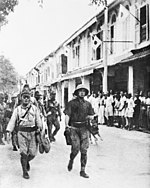








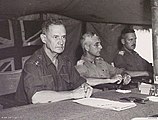
![Captain Susumi Hoshijima (centre) during the war crimes trial in Labuan, January 1946. He was found guilty of causing the deaths of POWs at Sandakan camp and subsequently hanged in 1946.[101]](http://upload.wikimedia.org/wikipedia/commons/thumb/7/71/Captain_Susumi_Hoshijima_AWM-133913.jpg/113px-Captain_Susumi_Hoshijima_AWM-133913.jpg)









